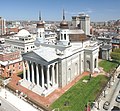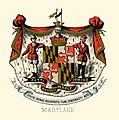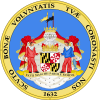|
Maryland Portal
|
Baltimore Task Force
|
Frederick Task Force
|
Montgomery Task Force
|
WikiProject Maryland
|
|
Main page
|
Discussion
|
Introduction Maryland (US: /ˈmɛrɪlənd/ MERR-il-ənd) is a state in the Mid-Atlantic region of the United States. The state borders Virginia to its south, West Virginia to its west, Pennsylvania to its north, Delaware to its east, the Atlantic Ocean, and the national capital of Washington, D.C. With a total area of 12,407 square miles (32,130 km2), Maryland is the ninth-smallest state by land area, and its population of 6,177,224 ranks it the 18th-most populous state and the fifth-most densely populated. Maryland's capital is Annapolis, and the most populous city is Baltimore. Occasional nicknames include Old Line State, the Free State, and the Chesapeake Bay State. It is named after Henrietta Maria, the French-born queen of England, Scotland, and Ireland during the 17th century. Maryland's coastline was first explored by Europeans in the 16th century. Prior to that, it was inhabited by several Native American tribes, mostly the Algonquian peoples and, to a lesser degree, Iroquoians and Siouans. As one of the original Thirteen Colonies, Maryland was founded by George Calvert, 1st Baron Baltimore, a Catholic convert who sought to provide a religious haven for Catholics persecuted in England. In 1632, Charles I of England granted Lord Baltimore a colonial charter, naming the colony after his wife, Henrietta Maria. Unlike the Pilgrims and Puritans, Lord Baltimore envisioned a colony where people of different religious sects would coexist under the principle of toleration. In 1649, the Maryland General Assembly passed an Act Concerning Religion, which enshrined this principle by penalizing anyone who "reproached" a fellow Marylander based on religious affiliation. Nevertheless, religious strife was common in the early years, and Catholics remained a minority, albeit in greater numbers than in any other English colony. Maryland's early settlements and population centers clustered around rivers and other waterways that empty into the Chesapeake Bay. Its economy was heavily plantation-based and centered mostly on the cultivation of tobacco. Demand for cheap labor from Maryland colonists led to the importation of numerous indentured servants and enslaved Africans. In 1760, Maryland's current boundaries took form following the settlement of a long-running border dispute with Pennsylvania. Maryland was an active participant in the events leading up to the American Revolution, and by 1776, its delegates signed the Declaration of Independence. Many of its citizens subsequently played key political and military roles in the war. Although then a slave state, Maryland remained in the Union during the American Civil War, its strategic location giving it a significant role in the conflict. After the Civil War, Maryland took part in the Industrial Revolution, driven by its seaports, railroad networks, and mass immigration from Europe. Since the 1940s, the state's population has grown rapidly, to approximately six million residents, and it is among the most densely populated U.S. states. , Maryland had the highest median household income of any state, owing in large part to its proximity to Washington, D.C., and a highly diversified economy spanning manufacturing, retail services, public administration, real estate, higher education, information technology, defense contracting, health care, and biotechnology. Maryland is one of the most multicultural states in the country; it is one of the six states where non-Whites compose a majority of the population, with the fifth-highest percentage of African Americans, and high numbers of residents born in Africa, Asia, Central America, and the Caribbean. The state's central role in U.S. history is reflected by its hosting of some of the highest numbers of historic landmarks per capita. (Full article...) This is a Featured article, which represents some of the best content on English Wikipedia..
Charles Carroll (1661 – 1720), sometimes called Charles Carroll the Settler to differentiate him from his son and grandson, was an Irish-born planter and lawyer who spent most of his life in the English Province of Maryland. Carroll, a Catholic, is best known for his efforts to hold office in the Protestant-dominated colony which eventually resulted in the disfranchisement of Maryland's Catholics. The second son of Irish Catholic parents, Carroll was educated in France as a lawyer before returning to England, where he pursued the first steps in a legal career. Before that career developed, he secured a position as Attorney General of the young colony of Maryland. Its founder George Calvert, 1st Baron Baltimore and his descendants intended it as a refuge for persecuted Catholics. Carroll supported Charles Calvert, 3rd Baron Baltimore, the colony's Catholic proprietor, in an unsuccessful effort to prevent the Protestant majority from gaining political control over Maryland. Following the overthrow of the Calvert proprietorship and the subsequent exclusion of Catholics from colonial government, Carroll turned his attention to owning slave plantations, law, business, and various offices in the proprietor's remnant organization. He was the wealthiest man in the colony by the time of his death. In the last years of his life, Carroll attempted to regain some vestige of political power for Catholics in the colony, but the Protestant colonial assembly and Governor John Hart disfranchised them. His son, Charles Carroll of Annapolis, became a wealthy planter and his grandson, Charles Carroll of Carrollton, also wealthy, was the only Catholic signer of the United States Declaration of Independence. (Full article...)General imagesIn the news
On this day...The Maryland portal currently doesn't have any anniversaries listed for May 31. You can help by viewing the page source of an existing entry at /On this day to see how the entries should be formatted, then adding the missing entry. This is a Good article, an article that meets a core set of high editorial standards.
The drug raid at the residence of Cheye Calvo, then-mayor of Berwyn Heights, Maryland, was a controversial action taken by the Prince George's County Sheriff's Office and Police Department on July 29, 2008. The raid was the culmination of an investigation that began in Arizona, where a package containing 32 pounds (15 kg) of marijuana was intercepted in a warehouse, addressed to the mayor's residence. Instead of confiscating the package, police allowed it to be delivered. Upon arrival, a SWAT team raided the house and held Calvo and his mother-in-law at gunpoint, and shot and killed his two dogs, one as it attempted to run away. The event gained national and international media attention. While the Calvos were cleared of wrongdoing, the police were accused by the Calvo family and civil rights groups of lacking a proper search warrant, using excessive force, and failure to conduct a proper background investigation of the home being raided—the investigation was so cursory that the sheriff's office was unaware that Calvo was the mayor. Despite the criticisms, no action has been taken against the officers or their respective police departments. In August 2010, Sheriff Michael A. Jackson stated that: "We've apologized for the incident, but we will never apologize for taking drugs off our streets. Quite frankly, we'd do it again. Tonight." (Full article...)Selected article -Baltimore is the most populous city in the U.S. state of Maryland. With a population of 585,708 at the 2020 census, it is the 30th-most populous city in the United States. Baltimore was designated an independent city by the Constitution of Maryland in 1851, and is currently the most populous independent city in the nation. As of the 2020 census, the population of the Baltimore metropolitan area was 2,838,327, the 20th-largest metropolitan area in the country. When combined with the larger Washington metropolitan area, the Washington–Baltimore combined statistical area (CSA) has a 2020 U.S. census population of 9,973,383, the third-largest in the country. The land that is present-day Baltimore was used as hunting ground by Paleo-Indians. In the early 1600s, the Susquehannock began to hunt there. People from the Province of Maryland established the Port of Baltimore in 1706 to support the tobacco trade with Europe, and established the Town of Baltimore in 1729. (Full article...)Did you know?

SubcategoriesSelect [+] to view subcategories
TopicsRelated portalsAssociated WikimediaThe following Wikimedia Foundation sister projects provide more on this subject:
Discover Wikipedia using portals |























































